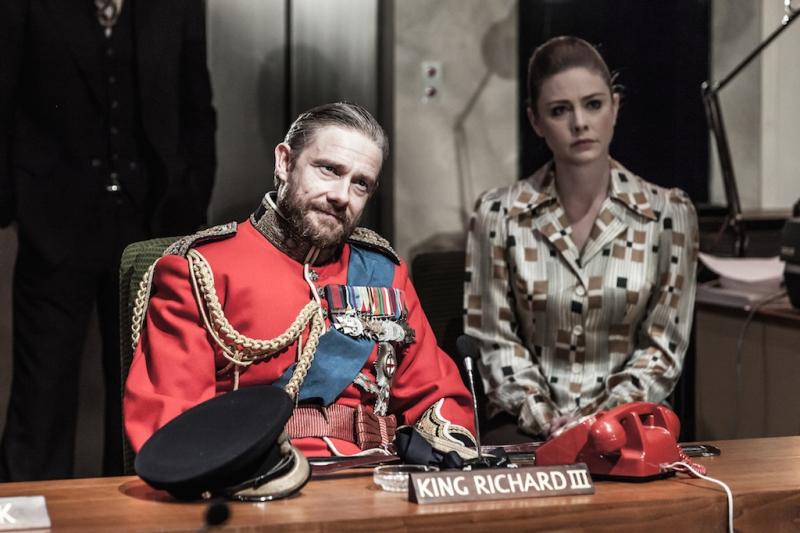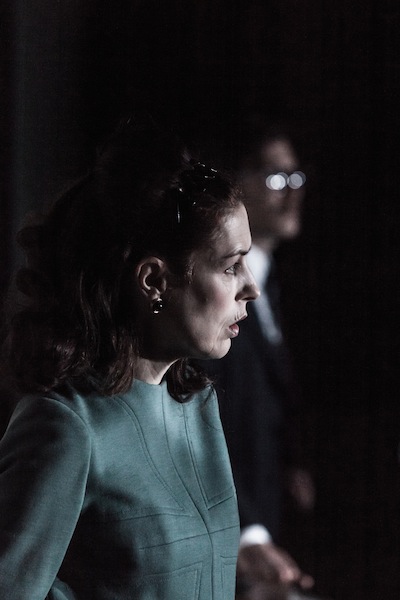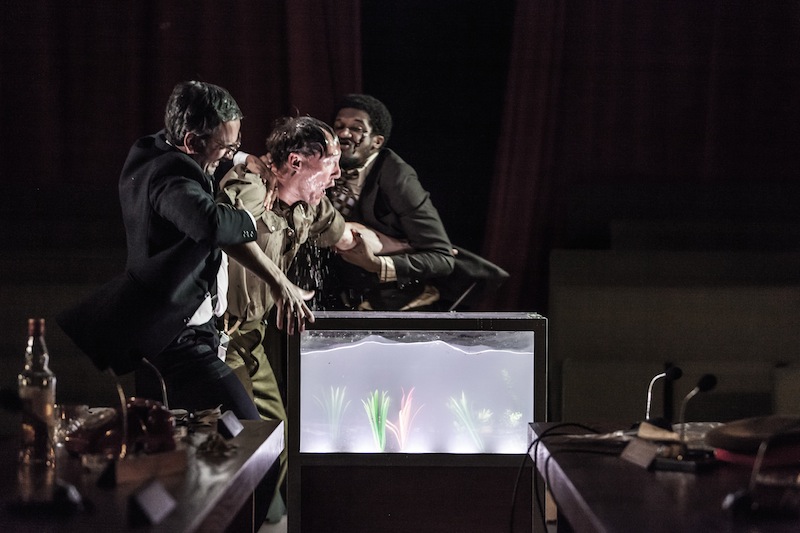Richard III, Trafalgar Studios | reviews, news & interviews
Richard III, Trafalgar Studios
Richard III, Trafalgar Studios
Martin Freeman’s smooth villainy fails to reveal the twisted depths of his hunchback king

Imagine Dr Watson trying his hand at Moriarty? That’s not the challenge of this Richard III, but the exciting prospect instead is to see an actor usually called upon to be the sidekick and nice guy asked to come front and centre as a diabolical villain.
I still don’t doubt that Martin Freeman has the chops for such a transition. That said, he doesn’t quite pull it off. The irony is that while he has brought a new dimension to his small-screen Watson, as a casualty of war fuelled by a certain self-loathing, he doesn’t offer a similar psychological depth to a character who demands it.
Freeman’s failure is also that of Jamie Lloyd’s production, which is entertaining and occasionally thrilling, but whose interpretation leaves its central character without his customary motivation.
The conceit is to cast Shakespeare’s “winter of discontent” forward to Britain’s similarly-named period of political and social upheaval in the late Seventies. What Richard decries as the “weak piping time of peace” becomes the uneasy truce between bureaucrats, union barons and the military, with class and regional differences to the fore, Richard planning the sort of coup that many believe was contemplated during that tumultuous decade.
 In Soutra Gilmour’s set, the scene of politicking and conspiracy is not the court, but a bland committee room, two long tables facing each other with place settings for the King and others (which will change during the course of the power struggle), flanked by office desks, telephones and television sets. An elevator is to one side, a dirty Union Jack nearby; the constant malfunctioning of everything in the room represents the pervading sense of society falling into disrepair and decay.
In Soutra Gilmour’s set, the scene of politicking and conspiracy is not the court, but a bland committee room, two long tables facing each other with place settings for the King and others (which will change during the course of the power struggle), flanked by office desks, telephones and television sets. An elevator is to one side, a dirty Union Jack nearby; the constant malfunctioning of everything in the room represents the pervading sense of society falling into disrepair and decay.
The play opens with a burst of noise, scenes of unrest on the TV sets and the eruption into the room of soldiers wearing gas masks. Amongst these is Richard himself, who grabs a microphone in order to praise the “glorious summer” to Edward directly, before addressing his real intentions to the audience.
There’s none of the "bottled spider" here, more a military man who has nonchalantly decided that he wants power for himself. His seduction of Lady Anne (Lauren O’Neil) is followed by a shrug of the shoulders and a knowing glance, as if to say, “why not?” Freeman’s clipped, RP delivery and matter-of-fact villainy projects an upper class caddishness, while evoking Alec Guinness’s smoothly psychotic Ealing villains. Richard’s deformities are made light of: the arm stiffly and inconspicuously hangs to one side, the hump is modest, and the limp non-existent until Richard ramps up an exaggerated one for PR effect.
This is a novel, even daring approach, but also limiting – missing the self-loathing and the twisted psychology that drives Richard’s ambitions, and the play itself. As the offhand gestures after each crime become repetitive, and lose their comic charm, we cry out for something more.
Around Richard, the re-imagining of the court as a contemporary political milieu is nicely worked, with Buckingham (Jo Stone-Fewings) as a preening civil servant who manages Richard’s ascension with brilliant showmanship, and Hastings (Forbes Masson) a sweaty union baron who looks like a cross between Scargill and Kinnock; the Woodvilles, those hated outsiders, are northerners – Gina McKee’s Queen Elizabeth (pictured above) conveying enormous gravitas, but Joshua Lacey’s shiny-suited Rivers coming across as someone you’d expect to see on a bad Saturday night in Newcastle.
 It’s also nice to see the intrigue given a public dimension, underlined by the use of the onstage microphones at key moments – Richard’s opening soliloquy, Queen Margaret’s curse, Buckingham’s rallying call for Richard, Edward’s entreating of his bickering countrymen to “swear your love”, which plays like an arbitration during which tea and sandwiches are served.
It’s also nice to see the intrigue given a public dimension, underlined by the use of the onstage microphones at key moments – Richard’s opening soliloquy, Queen Margaret’s curse, Buckingham’s rallying call for Richard, Edward’s entreating of his bickering countrymen to “swear your love”, which plays like an arbitration during which tea and sandwiches are served.
As with Lloyd's Macbeth, the imagination extends to the bloodletting. The murder of Clarence, drowned in a fish tank (pictured above), leaves you wondering how they pulled it off so realistically; Richard’s murder of Anne (something we don’t usually see) has an execution of which Hitchcock would have been proud.
And yet the choreographed violence feels like a distraction, taking not just a lot of time, but time that may have been better spent on character. The set itself comes to reflect the play’s shortcomings: for a few scenes it feels wonderfully apt, but by the end cluttered and constraining, like a dance floor with too many chairs.
rating
Explore topics
Share this article
The future of Arts Journalism
You can stop theartsdesk.com closing!
We urgently need financing to survive. Our fundraising drive has thus far raised £49,000 but we need to reach £100,000 or we will be forced to close. Please contribute here: https://gofund.me/c3f6033d
And if you can forward this information to anyone who might assist, we’d be grateful.

Subscribe to theartsdesk.com
Thank you for continuing to read our work on theartsdesk.com. For unlimited access to every article in its entirety, including our archive of more than 15,000 pieces, we're asking for £5 per month or £40 per year. We feel it's a very good deal, and hope you do too.
To take a subscription now simply click here.
And if you're looking for that extra gift for a friend or family member, why not treat them to a theartsdesk.com gift subscription?
more Theatre
 The Maids, Donmar Warehouse review - vibrant cast lost in a spectacular-looking fever dream
Kip Williams revises Genet, with little gained in the update except eye-popping visuals
The Maids, Donmar Warehouse review - vibrant cast lost in a spectacular-looking fever dream
Kip Williams revises Genet, with little gained in the update except eye-popping visuals
 Ragdoll, Jermyn Street Theatre review - compelling and emotionally truthful
Katherine Moar returns with a Patty Hearst-inspired follow up to her debut hit 'Farm Hall'
Ragdoll, Jermyn Street Theatre review - compelling and emotionally truthful
Katherine Moar returns with a Patty Hearst-inspired follow up to her debut hit 'Farm Hall'
 Troilus and Cressida, Globe Theatre review - a 'problem play' with added problems
Raucous and carnivalesque, but also ugly and incomprehensible
Troilus and Cressida, Globe Theatre review - a 'problem play' with added problems
Raucous and carnivalesque, but also ugly and incomprehensible
 Clarkston, Trafalgar Theatre review - two lads on a road to nowhere
Netflix star, Joe Locke, is the selling point of a production that needs one
Clarkston, Trafalgar Theatre review - two lads on a road to nowhere
Netflix star, Joe Locke, is the selling point of a production that needs one
 Ghost Stories, Peacock Theatre review - spirited staging but short on scares
Impressive spectacle saves an ageing show in an unsuitable venue
Ghost Stories, Peacock Theatre review - spirited staging but short on scares
Impressive spectacle saves an ageing show in an unsuitable venue
 Hamlet, National Theatre review - turning tragedy to comedy is no joke
Hiran Abeyeskera’s childlike prince falls flat in a mixed production
Hamlet, National Theatre review - turning tragedy to comedy is no joke
Hiran Abeyeskera’s childlike prince falls flat in a mixed production
 Rohtko, Barbican review - postmodern meditation on fake and authentic art is less than the sum of its parts
Łukasz Twarkowski's production dazzles without illuminating
Rohtko, Barbican review - postmodern meditation on fake and authentic art is less than the sum of its parts
Łukasz Twarkowski's production dazzles without illuminating
 Lee, Park Theatre review - Lee Krasner looks back on her life as an artist
Informative and interesting, the play's format limits its potential
Lee, Park Theatre review - Lee Krasner looks back on her life as an artist
Informative and interesting, the play's format limits its potential
 Measure for Measure, RSC, Stratford review - 'problem play' has no problem with relevance
Shakespeare, in this adaptation, is at his most perceptive
Measure for Measure, RSC, Stratford review - 'problem play' has no problem with relevance
Shakespeare, in this adaptation, is at his most perceptive
 The Importance of Being Earnest, Noël Coward Theatre review - dazzling and delightful queer fest
West End transfer of National Theatre hit stars Stephen Fry and Olly Alexander
The Importance of Being Earnest, Noël Coward Theatre review - dazzling and delightful queer fest
West End transfer of National Theatre hit stars Stephen Fry and Olly Alexander
 Get Down Tonight, Charing Cross Theatre review - glitz and hits from the 70s
If you love the songs of KC and the Sunshine Band, Please Do Go!
Get Down Tonight, Charing Cross Theatre review - glitz and hits from the 70s
If you love the songs of KC and the Sunshine Band, Please Do Go!
 Punch, Apollo Theatre review - powerful play about the strength of redemption
James Graham's play transfixes the audience at every stage
Punch, Apollo Theatre review - powerful play about the strength of redemption
James Graham's play transfixes the audience at every stage

Add comment